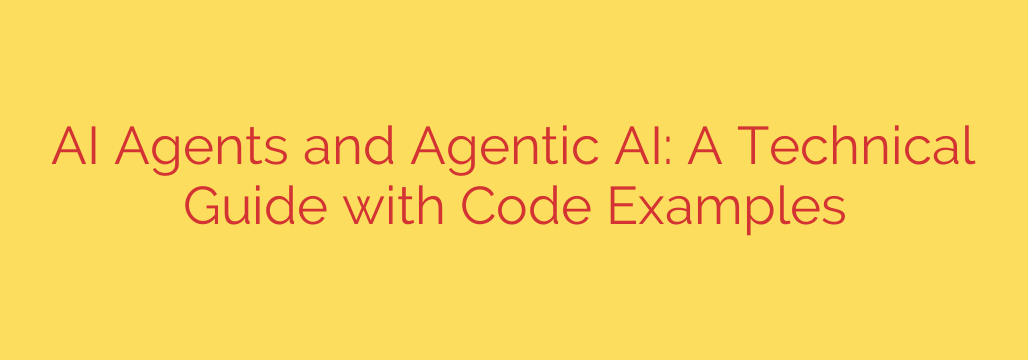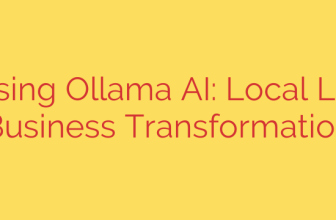
Beyond Chatbots: A Practical Guide to AI Agents and Agentic AI
We’ve all interacted with chatbots and AI assistants, but a new evolution in artificial intelligence is fundamentally changing what these systems can do. We’re moving beyond simple question-and-answer models to a world of autonomous AI agents—sophisticated systems that can reason, plan, and take action to achieve complex goals.
This isn’t just a minor upgrade; it’s a paradigm shift. Agentic AI represents the move from passive tools to active, digital partners capable of executing multi-step tasks in the real world. This guide explores what AI agents are, how they work, and the critical considerations for using them safely and effectively.
What is an AI Agent?
An AI agent is an autonomous system powered by a Large Language Model (LLM) that can perceive its environment, make decisions, and take actions to accomplish a specific goal.
Unlike a traditional chatbot that waits for your next prompt, an AI agent operates on a continuous loop of thinking, planning, and executing. Think of it less like a calculator and more like a digital intern. You don’t give it every single instruction; you give it a final objective, and it figures out the steps to get there.
The key differentiators are autonomy and the ability to use tools. An agent can decide on its own to browse a website, run a piece of code, or access a database to find the information it needs.
The Core Components of an AI Agent
To understand how these agents function, it’s essential to look at their four primary components.
1. The Brain: The Large Language Model (LLM)
At the heart of every AI agent is an LLM, such as OpenAI’s GPT-4 or Google’s Gemini. This is the central reasoning engine. The LLM processes information, breaks down complex goals into manageable steps, decides which tools to use, and analyzes the results of its actions. Its advanced reasoning capabilities are what enable the agent’s autonomous behavior.
2. The Toolbox: Access to External Functions
This is arguably what makes an agent truly powerful. Tools are external applications, APIs, or functions that the agent can call upon to interact with the outside world. An agent without tools is just a conversationalist; an agent with tools is an actor.
Common tools include:
- Web Search: To find up-to-date information.
- Code Interpreter: To write and execute code (e.g., for data analysis or file manipulation).
- API Connectors: To interact with other software like a CRM, a project management tool, or a calendar.
- Database Access: To query and retrieve specific data.
The ability to dynamically choose and use the right tool for a given sub-task is a core feature of agentic AI.
3. Memory: Providing Context and Continuity
For an agent to perform multi-step tasks, it needs a memory. This is broken down into two types:
- Short-Term Memory: This is managed within the “context window” of the LLM. It holds the history of the current conversation and recent actions, allowing the agent to remember what it just did.
- Long-Term Memory: For more persistent knowledge, agents can use external memory systems like vector databases. This allows an agent to recall information from past tasks or be pre-loaded with vast amounts of specialized documentation, giving it a permanent knowledge base to draw from.
4. The Planner: Task Decomposition and Reasoning
An agent doesn’t just blindly execute commands. It first creates a plan. Using reasoning frameworks (like the popular “ReAct” – Reason and Act model), the agent follows a continuous loop:
- Observe: It analyzes the current state and the overall goal.
- Think: It reasons about the next logical step and decides if a tool is needed.
- Act: It executes the chosen action (e.g., calls the web search tool).
- Repeat: It observes the outcome of its action and uses that new information to plan the next step, refining its approach until the final goal is achieved.
Practical Applications and Use Cases
The potential for agentic AI is vast and spans nearly every industry. Here are a few compelling examples:
- Automated Research and Analysis: An agent can be tasked with “researching the latest market trends for electric vehicles, gathering data from the top five financial reports, and generating a summarized slide deck.” It would autonomously search the web, analyze PDFs, extract key figures, and assemble the final presentation.
- Complex Code Generation: A developer could ask an agent to “build a Python web application with a user authentication system and a connection to a PostgreSQL database.” The agent would write the code, debug it, and even manage the file structure.
- Proactive Customer Support: An advanced support agent could not only answer a customer’s question but also access their account, diagnose a technical issue, and process a refund or replacement order without human intervention.
- Personalized Travel Planning: An agent could plan an entire vacation based on a simple prompt, booking flights, hotels, and dinner reservations that align with your stated preferences and budget.
Critical Risks and Security Considerations
While the potential is exciting, granting autonomy to AI systems comes with significant risks. Implementing agentic AI requires a security-first mindset.
- Uncontrolled Actions: The biggest risk is an agent taking unintended, harmful actions. Granting an AI agent access to a terminal or file system is extremely dangerous if not properly controlled. It could potentially delete files, execute malicious code, or leak sensitive data.
- Security Tip: Always run AI agents in a sandboxed environment (like a Docker container) with restricted permissions. Never give an agent direct access to production systems or sensitive internal networks.
- Hallucinations and Reliability: LLMs can still “hallucinate” or generate incorrect information. An agent acting on false information could lead to poor business decisions or failed tasks.
- Security Tip: Implement a human-in-the-loop (HITL) approval process for critical actions. Before an agent executes a high-stakes task (like making a purchase or sending a mass email), it should require confirmation from a human user.
- Excessive Costs: Since agents make multiple calls to the LLM during their reasoning loop, costs can spiral quickly. A complex task could involve dozens of expensive API calls.
- Security Tip: Set strict usage limits, monitor token consumption closely, and configure alerts to prevent runaway costs.
The Future is Autonomous
AI agents represent a fundamental shift in how we interact with technology. We are moving from a command-based relationship to a goal-oriented partnership. As these systems become more sophisticated and reliable, they will unlock new levels of productivity and automation, handling complex workflows that were previously the exclusive domain of human experts.
However, realizing this future responsibly requires a deep understanding of both their capabilities and their limitations. By focusing on robust security measures, clear oversight, and thoughtful implementation, we can harness the power of agentic AI to build a more efficient and intelligent future.
Source: https://collabnix.com/ai-agents-vs-agentic-ai-a-complete-technical-guide-with-code-examples-2025/








